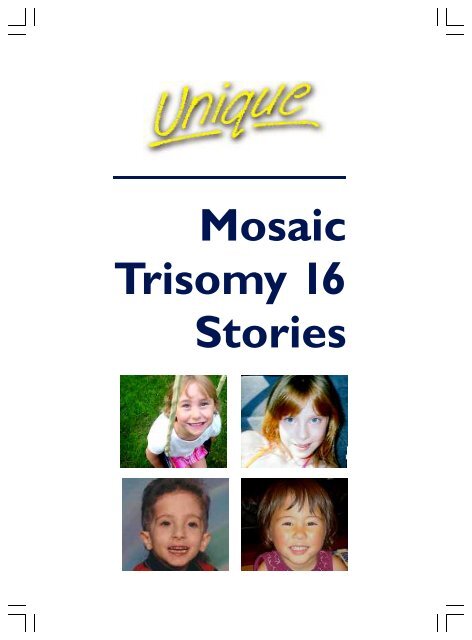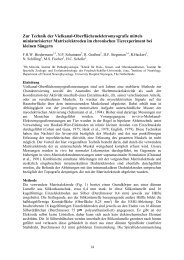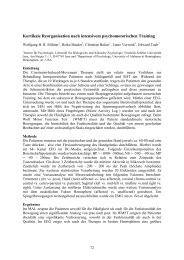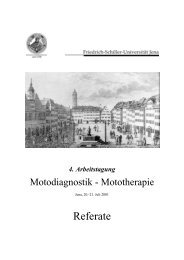T16M Stories FTNW.pub
T16M Stories FTNW.pub
T16M Stories FTNW.pub
Create successful ePaper yourself
Turn your PDF publications into a flip-book with our unique Google optimized e-Paper software.
Mosaic<br />
Trisomy 16<br />
<strong>Stories</strong>
2<br />
Cameron<br />
Cameron was born in 1999 after his mother discovered during pregnancy<br />
that he had mosaic trisomy 16. An amniocentesis was performed at 18<br />
weeks after the triple test showed a very high risk (1: 8) of a chromosomal<br />
disorder. This revealed the mosaic trisomy and showed that 50 per cent of<br />
Cameron’s cells contained an extra chromosome 16. When Cameron’s own<br />
blood was tested after birth, no trisomy 16 cells were found.<br />
Cameron was born after his mother went into spontaneous labour at 27<br />
weeks. Medication delayed delivery until 28 weeks but Cameron was born<br />
by emergency Caesarean after the cord prolapsed and his heart stopped. At<br />
birth his Apgar scores were 1 at one minute and 5 at five minutes. He was<br />
ventilated immediately but had an intraventricular haemorrhage (a bleed into<br />
the brain) at birth. He stayed in hospital for 11 weeks and came home on<br />
oxygen. Cameron was born tiny, weighing 794 grams. By two months of age<br />
he weighed 1440 grams (3lb 3oz) and by his first birthday he weighed 6820<br />
grams (15lb 4oz). At four years and five months, he weighed 12 kilos 700<br />
grams (28lb). He has always been short and remains so, on or below the<br />
0.4 th centile for height and growth since birth.<br />
Feeding has been difficult. Initially, Cameron’s heart and lung problems left<br />
him too breathless to breastfeed but he took small amounts by bottle. He<br />
has had gastro-oesophageal reflux (his feeds return up the food pipe) since<br />
birth and after developing an aversion to swallowing, was fed by nasogastric<br />
tube until he was 2 years old, when a gastrostomy tube was fitted, allowing<br />
him to be fed direct into the stomach. By 2½, he started to drink and to eat<br />
by 3¾.<br />
After a slow start, Cameron’s motor development has been within the<br />
normal range. He sat at 11 months and walked at 18 months. At 4½ , he is<br />
very agile, can run, jump, play football and ride a bicycle with stabilisers.<br />
Occupational and physiotherapy input played a part in Cameron reaching his<br />
developmental milestones. However, his main problem is physical strength.<br />
Cameron has no learning difficulties. At 4½, he knows his alphabet and was<br />
starting to form letters at the age of 3. He is talkative and has a good<br />
vocabulary, using long and complex sentences and understanding at the same<br />
level. He had speech therapy to the age of 3½ when it was discontinued as<br />
unnecessary. He is determined and cheerful and makes friends easily.<br />
Medically, Cameron was born with a small coarctation (tight narrowing) of<br />
the aorta, which resolved without treatment. He developed pulmonary<br />
hypertension and was oxygen dependent for his first year and developed<br />
chronic lung disease. His pulmonary hypertension was successfully treated<br />
and he is now healthy and has no after effects. He also has one lowered
eyelid and one lazy eye for which his ‘good’ eye has been patched daily. The<br />
haemorrhage at birth left no lasting effects.<br />
Katie<br />
Katie was born in 1998 after a triple test<br />
followed by amniocentesis at 19 weeks<br />
showed mosaic trisomy 16. Katie’s<br />
mother was given an appointment for a<br />
detailed scan at 20 weeks which showed<br />
that her baby was small but appeared<br />
well. Her brain and heart seemed well<br />
formed although there was some<br />
concern over her spine. Having seen<br />
their baby on scan, Katie’s parents found<br />
it impossible to even dream of ending<br />
the pregnancy. They decided that they<br />
would care for her and deal with any<br />
problems she might have.<br />
Between 31 weeks and 36 weeks in the<br />
pregnancy, Katie did not grow. When a<br />
routine scan at 36 weeks confirmed that the blood supply from the placenta<br />
was poor and that Katie was not growing, a Caesarean section was<br />
scheduled and she was born the following morning. The theatre was packed<br />
with midwives, paediatricians and obstetricians.<br />
Katie’s parents held hands as the obstetricians delivered their daughter – a<br />
normal, healthy, if small baby weighing 1650 grams (3lb 10oz). At birth, a<br />
sample of blood was taken from the umbilical cord, and this showed no<br />
trisomy 16 cells. Katie’s parents decided against taking biopsy samples from<br />
her skin.<br />
Although Katie was well, she was reluctant to feed and she spent her first<br />
four days in special care where she was fed by nasogastric tube. After three<br />
more days on the postnatal ward with her mother, Katie was ready to go<br />
home.<br />
Feeding got off to a slow start: Katie was breastfed with difficulty for three<br />
weeks but then took to the bottle well and moved on to solids at 4 months<br />
without problems. From the age of 18 months, her appetite has been small<br />
and she has needed prompting to eat. Although Katie has a very varied diet,<br />
she can take as long as an hour to eat a small amount. Katie’s reluctance to<br />
eat has been paralleled by slow weight gain. Her parents were told that she<br />
would always be small for her age and she has been. At 6, Katie had not<br />
3
4<br />
grown or put on any weight for the past two years. Her growth hormone<br />
levels were normal and paediatric and genetic consultants were unable to<br />
offer any solutions. By now, Katie was aware of her height and wondered<br />
why she was smaller than all her friends. After seeking a second opinion, it<br />
was decided to start Katie on growth hormone treatment.<br />
Katie’s motor development has proved to be normal. She received<br />
physiotherapy for four months from the age of two months, but sat alone at<br />
four months and walked without problems at 14 months. She has no<br />
learning difficulties, started writing and using a computer at 4 and reading at<br />
5. She attends a regular (mainstream) school without any learning support.<br />
She has no difficulties with speech or language and both understands and<br />
expresses herself fluently. She has a strong, outgoing personality and is very<br />
determined.<br />
Katie has no birth defects and her only health problems have been recurrent<br />
ear and chest infections, leading to repeated drainage of the middle ear to<br />
improve her hearing. She has mild asthma which has improved since<br />
babyhood.<br />
All in all, Katie is a happy, healthy little girl whose only problem is her small<br />
stature.<br />
Emily<br />
The pregnancy with Emily was a<br />
rollercoaster from the start. Emily was<br />
conceived after treatment following two<br />
years of infertility. An early episode of<br />
unexplained spotting was followed two<br />
weeks later by a scan showing an<br />
unusually small sac and the doctor<br />
warned Emily’s anxious parents that<br />
there was a good chance of losing the<br />
pregnancy. But the next scan was<br />
reassuring and the first serious concerns<br />
only surfaced when two serum screening<br />
tests (Tri-screen) came back with an<br />
abnormal result. Then came the blow.<br />
The amniocentesis showed 100 per cent<br />
of trisomy 16 cells. Everyone was<br />
dumbfounded, not least the doctor who<br />
could still find a strong heartbeat.<br />
Emily’s mother was referred immediately for a level II ultrasound scan and a
meeting with a genetic counsellor who revealed that the baby was a girl. Her<br />
parents named her Emily Marie and on ultrasound, Emily appeared to wave<br />
at her parents. She seemed perfectly healthy but with 100 per cent trisomy<br />
16 cells the medical prognoses were not positive and Emily’s parents were<br />
warned that they might very likely lose their baby. They left the hospital that<br />
day with very mixed emotions but they decided not to end the pregnancy. ‘If<br />
this baby was not going to live, it would not be by our hands,’ Emily’s<br />
mother said.<br />
Every month, Emily’s growth was monitored and every month she appeared<br />
a bit further behind in size. As the radiographers measured from head to<br />
toe, each part of her seemed to be a bit further behind than the last. More<br />
worries! But, again, nothing really seemed wrong.<br />
Six months into her pregnancy, Emily’s mother had a fetal echocardiogram<br />
(an ultrasound scan of the baby’s heart) and this time the news was<br />
devastating. Three or four major things were found to be wrong. A second<br />
scan was scheduled with a specialist whose verdict was more encouraging:<br />
some narrowing in the aortic valve (the valve between the left ventricle and<br />
the aorta, the artery from the heart to the body) that would need<br />
monitoring but was not too worrying. More good news came with further<br />
results from the amniocentesis that now showed that seven per cent of the<br />
cells were normal, confirming the genetic counsellor’s belief that Emily must<br />
have mosaic rather than full trisomy 16.<br />
At 31 weeks, the waters broke, Emily’s mother was given a steroid injection<br />
to mature the baby’s lungs and kept in hospital on strict bed rest while<br />
Emily’s progress was monitored regularly. Within days, she was moving<br />
noticeably less and the doctors decided it was time to deliver her.<br />
At 3.36pm on May 27th 2000, two months premature and weighing 2lb 6 oz<br />
(1078g), Emily came out crying loudly. Her Apgar scores were excellent. All<br />
the same, she was transferred to neonatal intensive care and after<br />
developing a serious bowel condition (necrotising enterocolitis, to which<br />
preterm babies are vulnerable) was to spend almost three months in<br />
hospital. Meanwhile, samples taken at birth confirmed 100 per cent trisomy<br />
16 cells in the cord blood and the placenta. Four months later, a skin sample<br />
was to show only four per cent trisomy 16 cells while Emily’s own blood<br />
showed none.<br />
Emily could not breastfeed but she took expressed breast milk for three<br />
months. Reflux (feeds returning from the stomach up the food pipe) was a<br />
major problem and she regularly scared her mother when her heart rate<br />
dipped while she was eating. Yet she slowly improved and gained weight<br />
until aged three months she was ready to come home.<br />
5
6<br />
Since then Emily has gone from strength to strength. Her forecast cardiac<br />
problems turned out to be mild aortic stenosis (narrowing), much as the<br />
cardiac specialist described from her second echocardiogram (heart scan).<br />
While she may need surgery for this later, for the time being she is just<br />
being monitored. At five months she had an inguinal hernia repaired.<br />
In other ways you would not distinguish Emily from other girls of her age.<br />
Just after her fourth birthday, Emily is tall and skinny, like her mother at the<br />
same age. With input from occupational and physiotherapy, she sat at 9<br />
months and walked at a year. Today she plays ‘soccer’, rides her bike and<br />
takes dance once a week. She has no learning difficulties and can write her<br />
name and most other letters. After initial delay in starting to speak – at 15<br />
months she was developmentally at a 12-month level and at 22 months she<br />
was still behind - she now talks like any other child. In every other way Emily<br />
is a normal four year old.<br />
‘Emily brings a smile to everyone she meets,’ says her mother. ‘My mom calls<br />
her ‘my golden baby’ because she is more precious than gold. Emily has<br />
taught us never to give up on your dreams.’<br />
Shayna<br />
Shayna was born on Valentine’s Day 1996, after<br />
29 weeks of pregnancy and just eleven weeks<br />
after her shocked parents learned that she had<br />
mosaic trisomy 16. The doctors had given a<br />
gloomy prognosis (death, handicap, learning<br />
disabilities) but when two days later Shayna<br />
seemed to wave to her parents on ultrasound<br />
they decided they could not possibly terminate.<br />
At birth, Shayna was tiny (1lb 10oz; 741 grams)<br />
and had a hole between the upper chambers of<br />
her heart. That apart, she was well and after 13<br />
weeks in neonatal care she came home.<br />
At the age of 8, Shayna was on the small side but had otherwise defied all<br />
the dire medical prognostications. In almost all subjects at school she was<br />
performing at an above average level. She loved gymnastics and hip-hop and<br />
had just performed in her school talent show. In her mother Karen Lange’s<br />
words, Shayna is ‘in every way a typical little girl’.
Bobby<br />
Bobby was born in 1991, four days before his<br />
due date. He was small, weighing just 4lb 10oz<br />
(1818 grams), and was to remain tiny all his life.<br />
However, at birth he needed no life support or<br />
medical interventions and went into neonatal<br />
care with the key aim of gaining weight.<br />
Investigations while he was there confirmed<br />
that Bobby had a heart defect called a double<br />
outlet right ventricle, which had already been<br />
identified during pregnancy, and that while he<br />
had no trisomy 16 cells in his blood, 12-13 per cent of the cells from his skin<br />
showed trisomy 16. What that meant was uncertain.<br />
Bobby had three surgical operations in his first 14 months – to repair<br />
inguinal hernias (in the groin), to correct hypospadias of his penis (the hole<br />
was on the underside of the shaft) and to correct his heart condition. Just<br />
when his parents thought they could relax, Bobby was found to have<br />
pulmonary hypertension, a condition in which the blood enters the lungs<br />
under too much pressure. In Bobby’s case, the veins that take oxygenated<br />
blood out of the lungs were found to be small and thickened and one of his<br />
lungs was also very tiny and not functioning properly.<br />
Bobby had a hard time even fighting off colds and when he caught an RSV<br />
(respiratory syncytial virus) infection, he was on 24-hour oxygen for six<br />
weeks. By his fifth winter, Bobby was fighting off infections better but his<br />
lungs were deteriorating, the blood vessels in both lungs were thickening<br />
and narrowing and the right lung was affected as well as the left. The next<br />
winter he developed a habitual cough. Then he started to vomit, and one day<br />
he coughed up blood. Twelve days before Christmas 1996, he died in his<br />
mother’s arms. He had had a pulmonary haemorrhage (a bleed in the lungs),<br />
caused by the pulmonary hypertension. Bobby was five years and three<br />
months old.<br />
Seija<br />
Seija was born in September 2002 after her mother’s waters broke and she<br />
went into spontaneous labour at 34.5 weeks. Her parents had known she<br />
was a MT16 baby for two months, after an amniocentesis because of<br />
suspected growth delay, too little amniotic fluid and an enlarged pad at the<br />
back of the baby’s neck had revealed 21% T16 cells. The geneticist warned<br />
of the risks of growth delay, abnormalities, preterm birth and the<br />
uncertainties that hang over the long term outcome for babies with MT16.<br />
7
8<br />
After a difficult two weeks, Seija’s parents decided to go ahead and Seija was<br />
born weighing 1280 grams (2lb 13oz), with Apgar scores of 6 and 9 and a<br />
large head and fontanelle. She cried, to her parents’ delight. Postnatally, Seija<br />
did well and when she left hospital aged three weeks her weight had risen to<br />
1700 grams. She continued to gain weight steadily at over 200 grams a week,<br />
taking breast milk at first from a bottle and later from the breast. By six<br />
months she started on baby rice.<br />
Investigations in hospital showed that Seija was a healthy if tiny baby and<br />
follow-up showed that she was babbling by six months and was contented<br />
and communicative. By eight months she was given an all clear by cardiology,<br />
the only clinical area where there were any concerns. By 14 months, Seija<br />
was standing alone, eating normally and very vocal. Her length was on the<br />
10 th centile and her head circumference on the 25 th , reinforcing the view that<br />
her slow growth before birth was caused by issues of placental function. She<br />
was found at birth to have two copies of her mother’s chromosome 16 and<br />
no copy of her father’s - maternal uniparental disomy 16, which is known to<br />
intensify growth delay in the womb.<br />
Seija’s mother takes up her story.<br />
‘My first reaction when I found out that I was expecting was ‘I hope I can<br />
carry this one.’ I had already had two miscarriages and didn’t want to give<br />
up hope but was tired of failing. My obstetrician performed the first<br />
ultrasound around seven weeks and arranged for another around 12 weeks.<br />
He mentioned then that the fetus looked a little small for the gestational age<br />
but knowing that the baby was alive was enough for me. Around 18 weeks, I<br />
had another ultrasound and this showed that the baby was too small for the<br />
due date to be determined. Another scan at 21 weeks showed growth<br />
retardation. I started to have a bad feeling.<br />
‘The baby might have Down’s syndrome’<br />
‘Two weeks later the obstetrician told my husband and me that the baby<br />
looked so small that he would like to investigate further. He told us that he<br />
saw some signs that a Down’s syndrome baby might have, such as growth<br />
retardation and extra skin around the neck and asked us if he could perform<br />
an amniocentesis right away. I was reluctant, as I knew there was a small<br />
chance that I might miscarry, but my husband convinced me that we should.<br />
We then went to see a genetic counsellor who explained to us what they<br />
are looking for with the rapid-result FISH tests for the most common<br />
chromosome abnormalities (signals that show whether there is an extra<br />
copy of chromosomes 21, 13, 18, X and Y) and that more thorough tests<br />
would be done to look at all the chromosomes.<br />
‘The genetic counsellor sounded excited when she called with the FISH
esults: we were not carrying a Down’s baby. It was a relief, but it was not<br />
to last long.<br />
Not Down’s but Mosaic Trisomy 16<br />
‘The long-term results showed that the baby had Mosaic Trisomy 16. This<br />
term was new to both of us and we had to ask the GP to write it down.<br />
She said 21% of the baby’s chromosomes were affected by mosaic trisomy<br />
16, 79% were normal. She suggested seeing a genetic specialist, as it is so<br />
rare that she hadn’t found much information about it. We left without<br />
knowing what to do. I started surfing the net and found little information,<br />
but everything we found was devastating. Then I found the DOC16 site at<br />
www,trisomy16.org with its stories of children who are healthy and doing<br />
well. I couldn’t read all the stories there without tears in my eyes.<br />
‘Next day, we saw a genetic counsellor who had collected all the<br />
information she could find, but admitted it was limited and she had never<br />
personally heard of Mosaic Trisomy 16. We didn’t know what to do when<br />
we left her.<br />
A teddy bear called Hope<br />
‘I was scheduled for another ultrasound and told my husband that I wanted<br />
to contact Karen Lange, the founder of DOC16, to see if I could get more<br />
information. Karen sent me a lot of information together with a teddy bear<br />
whose name is Hope.<br />
‘At the next ultrasound appointment, the obstetrician spent over an hour<br />
examining the baby. In my mind, this might be our last chance to see her<br />
alive and I had tears in my eyes all the time. Afterwards, he spent another<br />
hour discussing what he had seen and what our options were. It felt as if I<br />
was facing a death sentence. Yet he told us something we didn’t expect to<br />
hear: he could see the growth retardation, but all her organs seemed to be<br />
there and our daughter was at the good end of the spectrum. It was like a<br />
last minute reprieve, a glimpse of hope.<br />
Hoping for the best, preparing for the worst<br />
‘In our hearts we both decided that there was no way we could end the<br />
pregnancy, so we agreed to carry on. ‘Hoping for the best, preparing for<br />
the worst’ was something we kept saying to each other for the rest of the<br />
pregnancy.<br />
‘After making the decision, I felt much better. It was still hard seeing other<br />
pregnant women and I could not face attending prenatal classes. Some days<br />
were better than others, but I was unable to enjoy being pregnant.<br />
‘Around that time we had to decide how much treatment we would like for<br />
our daughter when she was born. The words of the head paediatrician will<br />
stay with me for ever. ‘If this was a normal baby, we would do whatever we<br />
9
can to save her,’ he said. ‘But she is not. We need to know how much<br />
treatment you would like for her.’ I felt as if I was carrying a non-human<br />
baby, something unwanted. Yet she was a most wanted, loved baby who just<br />
happened to have a rare disorder.<br />
A most wanted and loved baby<br />
‘My Caesarean section was booked. Finally, I thought, I would get to see my<br />
daughter. Outwardly, I was quite calm - excited to see her but scared in case<br />
she was not born alive. We heard her cry before we saw her and then she<br />
was taken away to a paediatrician who examined her for a couple of minutes<br />
and said ‘She is normal’. We couldn’t believe our ears. She was put into an<br />
incubator and transferred to a special care nursery. I wasn’t really aware<br />
who was in the room but my husband told me later that there were at least<br />
seven doctors, all curious to know what was going to happen.<br />
‘I was transferred to a recovery room and asked the nurses to make sure<br />
that my placenta was ready to be sent to Vancouver. I had talked to Dr.<br />
Wendy Robinson a couple of times before the delivery and arranged that I<br />
would send my placenta for her research. (Note) The next day passed like a<br />
dream. I went to see my daughter that night and had the chance to hold her<br />
for the first time. She was incredibly tiny but quite as beautiful as I had ever<br />
imagined.<br />
The smallest baby ever to go home<br />
‘Seija surprised everyone. Next day she was able to manage without the<br />
intravenous line to keep her sugar level up. After three days she did not<br />
need constant heart monitoring any more. A week after her birth day she<br />
was out of the incubator. She was small, but doing what she was supposed to<br />
do. At less then three weeks old, she was discharged. Her hospital<br />
paediatrician said that she was the smallest baby he had ever sent home. She<br />
weighed just over 1700 grams.<br />
‘Getting everything ready for her was quite a challenge for us. We had<br />
bought nothing, as I didn’t want to come home from the hospital after losing<br />
a baby and be surrounded by a house full of baby things. The only thing I<br />
managed to buy for her before her arrival was a little hat, and even that was<br />
too big for her!<br />
‘Since then, Seija has been growing nicely. She had a hard time latching on<br />
because she was too small and too weak at first. At first I rented a breast<br />
pump to collect milk for her and I must say that was the hardest part of being<br />
a mother, as I would give her a bottle and then express, then put the bottles<br />
in the fridge or freezer and boil all the accessories from the pump. Imagine<br />
standing in front of a big pot of boiling water for 20 minutes at three in the<br />
morning! Luckily, Seija started to latch on around the last week of<br />
10
November and was breastfed until she was 16 months old. I wanted to keep<br />
breastfeeding her as long as she wanted, but I got pregnant again and my<br />
milk production dropped drastically.<br />
‘Every month or two we have had visitors from the government’s Child<br />
Development Program to see how Seija is developing. She has passed all her<br />
milestones at the normal rate. She is a little bit late with her first words but<br />
I am sure this will come shortly. At 19 months without correcting for her<br />
prematurity, her weight was 10.6 kg. She is still small but not far off her<br />
peers.<br />
Yes, she is really here<br />
‘It took me almost a year to realise that she is here and will be staying. The<br />
turning point was our final routine visit to the geneticist. ‘Normal,’ he said.<br />
‘She is normal.’ He has seen lots of disorders and hearing ‘normal’ from his<br />
mouth was quite something.<br />
‘I cannot imagine what would have happened if we had decided to terminate<br />
the pregnancy. I am glad that both my husband and I agreed that we should<br />
continue. Seija is our living proof that even being diagnosed with a rare<br />
disorder, the outcome is not always a sad story.’<br />
Note: See link to website on back cover<br />
The circled dots show Seija’s<br />
catch-up growth<br />
11
Unique recommends that you read these personal stories of families’<br />
experiences with Mosaic Trisomy 16 in conjunction with its<br />
information booklet Mosaic Trisomy 16, available from Unique.<br />
Rare Chromosome Disorder Support Group,<br />
PO Box 2189,<br />
Caterham,<br />
Surrey CR3 5GN,<br />
UK<br />
Tel/Fax: +44(0)1883 330766<br />
info@rarechromo.org<br />
www.rarechromo.org<br />
Disorders of Chromosome 16 Foundation<br />
www.trisomy16.org<br />
If you have an MT16 pregnancy and wish to contribute to research, log onto the<br />
mosaicism website at the University of British Columbia<br />
www.medgen.ubc.ca/wrobinson/mosaic/index.htm<br />
Unique mentions other organisations’ message boards and websites to help families looking for<br />
information. This does not imply that we endorse their content or have any responsibility for it.<br />
This leaflet is not a substitute for personal medical or genetic advice. Families<br />
should consult a medically qualified clinician in all matters relating to genetic<br />
diagnosis, management and health. The information is believed to be the best<br />
available at the time of <strong>pub</strong>lication and the medical content has been verified by<br />
Dr Wendy Robinson, Associate Professor of Medical Genetics, University of<br />
British Columbia and Monica Pearson BSc 2004.<br />
Copyright © Unique 2004/1<br />
Rare Chromosome Disorder Support Group Charity Number 1110661<br />
Registered in England and Wales Company Number 5460413<br />
12











